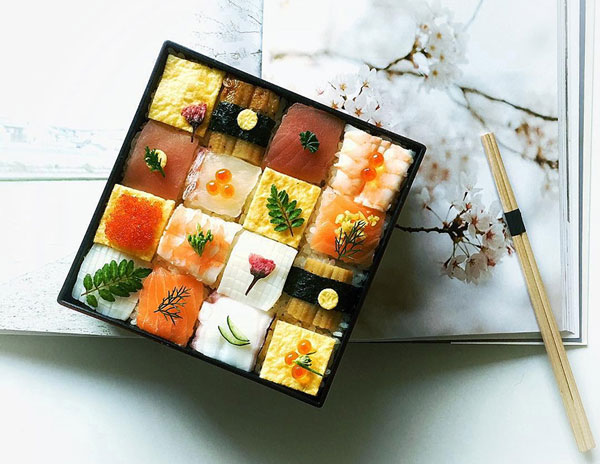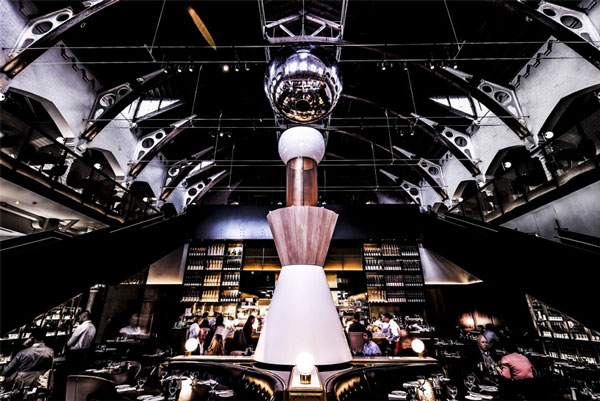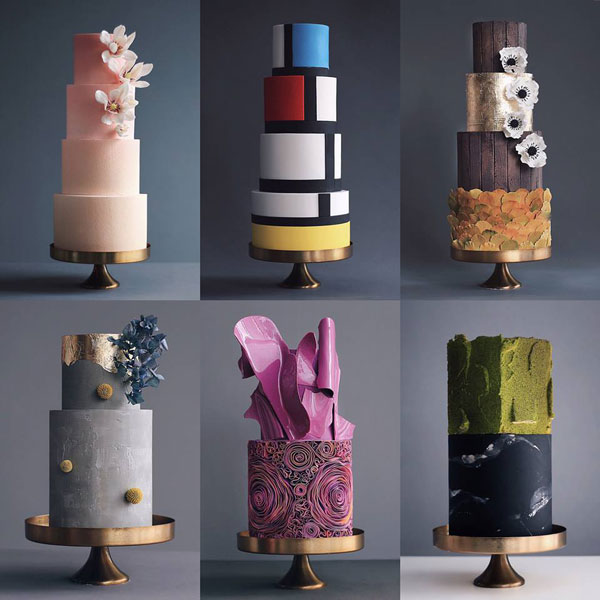From still life depictions in Renaissance paintings to pop-art depictions of canned Campbell’s soups, food has been finding its way into art for many years. In fact, you can learn a lot about a particular time period by analyzing its food art.

(Image source: @chinamisakamoto)
And, today’s obsession with food as art is no different. Food plays a major role in our modern visual culture, fueled by social media and chefs who use food both as a raw material and a way to convey certain messages.
Here are five unique artists who use food as their primary materials to create spectacular pieces—some of which will make you hungry and some of which will leave you questioning yourself:
Studio Appetit
First in our food art list is Studio Appétit, a multidisciplinary design studio that specializes in what they refer to as, “Eating Design and culinary oriented projects”.
Studio Appétit uses food as their main weapon to create enhanced multisensory experiences. Experiences that include design objects, edible products, eating installations, multisensory brand experiences, dining concepts, restaurant art direction, lectures, workshops and more.
Led by designer and chef, Ido Garini, Studio Appétit has come to be considered one of the best in the food art field, and a pioneer in establishing food design as a legitimate medium within the greater design world.

(Image source: www.designboom.com)
“The Food Religion”, one of their many projects, is a concept they developed in collaboration with Conran + Partners, where they challenge the boundaries between food and faith. Ido explains, “It is the merge of our love to challenge conventional boundaries of traditional disciplines and translate them into new worlds of sensory stimulations with the striking relevance of food culture in all walks of life”.
The project consists of a central installation which emulates a holy shrine within a temple and several tasting plates that further the concept of food and spirituality. The base of the installation is made from claybrook stone and represents the foundations of food and cooking that grow into a celebration of consumption.
Dinara Kasko
What do 3D printers have to do with baking? Everything, according to Ukranian pastry chef, Dinara Kasko.
Dinara has made her mark on the food art scene by innovating a unique baking technique that utilizes mathematical algorithms and three dimensional printing. The results are outstanding geometric cake designs that make you wonder whether the final product is in fact, edible.

(Image source: www.ufunk.net)
She begins her process by printing 3D molds using top of the line modeling software which simulates the interaction of objects in space, all while taking into account factors such as shapes, material properties and gravity.
Her latest concoction is an algorithmically-modeled cake made of eighty one uniquely shaped pieces, made to highlight Barry Callebaut’s ‘ruby chocolate’ for the ruby chocolate event in Shanghai, China. The design for the cake was inspired by the work of artist and paper engineer, Matthew Shlian.
For this cake, she took the traditional pyramid form and carefully tweaked the tilt of the composition. As a result, each angled form works together to create an overall dynamic shape.

(Image source: www.ufunk.net)
However, the design is not the only thing that’s incredible about this cake. The taste is too.
Made with mousse, ganache, chocolate ruby meringue, and berry confit at the center, each piece highlights the berry flavor of the chocolate and is complimented by a perfectly textured biscuit underneath.
Emily Coumbis
25 year old Brisbane Barista, Emily Coumbis, joins the food art scene with colorful latte creations.
Emily was first inspired to create rainbow foamed lattes after watching a video of a Las Vegas man who used colored dyes to make lattes. At the time, the Piggy Back cafe where she was working had just opened and traffic was slow. So, she purchased a few dyes and began experimenting. It wasn’t long before her boss took notice and loved the idea.

Today, Emily makes a little over 300 cups of rainbow lattes a week and has become a rainbow latte social media sensation. Her Instagram account boasts over 33,000 followers with her pictures and videos receiving thousands of views and likes from people all over the world. Customers have even come from as far as Singapore to try her rainbow lattes.
The rainbow effect is produced through adding drops of blue, pink and yellow food coloring into the foamed milk and swirling it together to create secondary colors. Emily pours intricate designs with the dyed milk such as swans, flowers and unicorns, each one with a different color combination because as she says, “You can’t get those drops in the same spot every time so everything looks different—Every coffee is unique in its own way.”
Cedric Grolet
“Nothing is as it seems” is the perfect way of describing pastry chef, Cedric Grolet’s desserts.
Cedric Grolet breaks the conventional rules of French dessert by creating surreal pastries that look exactly like fruit—oranges, lemons, strawberries, and apples, typically filled with unexpected sweet fillings and a cake-like outer shell. It’s no wonder he was named “Meilleur Pâtissier du Monde” or “Best Patissier in the World” in 2017.

(Image source: www.vogue.com)
His inspiration comes from childhood when his mother would feed him fruit instead of sweets for his mid-afternoon snack. He exclaims, “Early on, I started picking fruit, strawberries in particular, to make a little bit of money. I developed my palate pretty quickly and experimented with various fruit flavors.”

The accuracy of his fruit pastries are so authentic that if you quickly scroll past them on Instagram you would have no idea they aren’t the real thing. The apricots have an incredibly organic fuzzy outer texture while the lemons and limes come complete with natural looking “rinds”, green leaves and all.
And, like many other food artists, he has become a social media star with over 700,000 followers being mesmerized on Instagram by his daily creations.
Tortik Annuchka
Moscow based Tortik Annuchka, founded by sibling duo Madina and Tortik Yavorskaya, is not your average bakery. The family-run pastry business features an incredibly impressive selection of fine-art cakes embellished with artistic and architectural flair.

(Image source: www.tortik-annuchka.com)
This isn’t surprising as Madina was academically trained in fine arts, while Tortik has a background in architecture. Together, their bakery produces cakes unlike any you’ve seen before in organic patterns, abstract embellishments, and asymmetrical and geometric compositions.
The business is an expression of both Madina and Tortik’s dedication to handcrafted, homemade desserts. As you can imagine, the process of making just one cake is a demanding labor of love and experimental expression of creativity. Madina explains that, “creating a single cake may take a week” and that, “ideas simply come to us, and sometimes, they emerge as we experiment.”
Not only does Tortik Annuchka sell specialty cakes for weddings and other celebrations, they’ve also began a baking school where they offer a variety of classes such as, cupcake design, macaron making and more.
